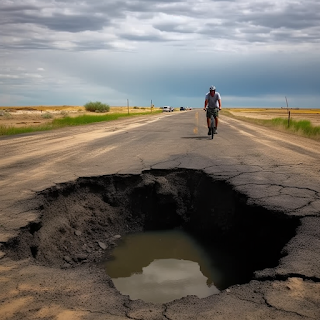How to Avoid Common Road Hazards While Cycling
Riding a bicycle is an excellent way to stay active, enjoy the outdoors, and reduce your carbon footprint. But sharing the road—especially with cars and unpredictable surfaces—comes with its own set of risks. To ride confidently and safely, cyclists need to stay alert and learn how to handle common road hazards.
Here’s what to watch out for—and how to avoid trouble on the road.
Common Road Hazards for Cyclists
1. Potholes
Potholes are one of the most common dangers. Hitting one at high speed can damage your wheels or throw you off your bike.
Avoid them by:
-
Scanning the road 10–15 feet ahead.
-
Steering around them if it's safe.
-
Rising slightly off your saddle when hitting one to absorb the impact with your legs.
2. Loose Gravel
Gravel reduces traction, especially in corners or when braking. It’s most dangerous on shoulders, intersections, and rural roads.
Stay safe by:
-
Slowing down before turning or braking.
-
Riding in a straight line through gravel sections.
-
Giving other cyclists space so they don’t kick up debris.
3. Railroad Tracks
Tracks are slippery, uneven, and can catch your wheels if you approach at the wrong angle.
Cross safely by:
-
Approaching at a 90-degree angle.
-
Keeping both hands firmly on the handlebars.
-
Staying centered on your bike to maintain control.
4. Car Doors (a.k.a. the “Door Zone”)
Drivers opening their doors into the path of a cyclist is a major urban hazard.
Avoid dooring accidents by:
-
Riding at least 3–4 feet away from parked cars.
-
Watching for brake lights or movement in parked vehicles.
-
Being ready to brake or swerve if needed.
5. Uneven Surfaces
Cracked pavement, speed bumps, or metal grates can jar your ride—or worse, cause a crash.
Handle them by:
-
Slowing down as you approach.
-
Staying balanced and keeping your weight centered.
-
Avoiding sudden turns or braking when on uneven terrain.
Smart Riding Habits to Avoid Hazards
1. Stay Alert and Aware
Look ahead, scan side to side, and keep an eye on vehicles, pedestrians, and other cyclists. Your safety depends on awareness.
2. Use Hand Signals
Clearly signal your turns and stops to alert drivers and fellow cyclists. Predictability helps everyone stay safer on the road.
3. Avoid Distractions
Leave your phone in your pocket and keep both ears free. Music or texting can make you miss warning signs or obstacles.
4. Ride Defensively
Assume drivers may not see you. Position yourself visibly in the lane when needed, and avoid blind spots—especially near trucks or buses.
5. Watch the Weather
Wet roads can be slick, and debris may hide under puddles. In snow or heavy rain, slow down and be extra cautious with braking and cornering.
6. Check Your Equipment
Before each ride, check:
-
Brakes
-
Tire pressure and tread
-
Lights and reflectors
A well-maintained bike can help you avoid accidents caused by mechanical failure.
7. Use Lights and Reflective Gear
At dawn, dusk, or night, front and rear lights are essential—and legally required in many places. Reflective clothing increases your visibility even more.
Final Thoughts: Ride Smart, Ride Safe
Cycling can be one of the safest and most enjoyable ways to stay fit and explore your surroundings—but it does require vigilance. By staying aware of road hazards and preparing for them, you can drastically reduce your risk of injury.
Always wear your helmet, obey traffic laws, and respect others on the road. With the right habits, you can enjoy all the benefits of biking while staying safe and confident every mile of the way.



Comments
Post a Comment